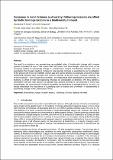Increases in local richness (α-diversity) following invasion are offset by biotic homogenization in a biodiversity hotspot
Abstract
The world's ecosystems are experiencing unparalleled rates of biodiversity change, with invasive species implicated as one of the drivers that restructure local assemblages. Here we focus on the processes leading to biodiversity change in a biodiversity hotspot, the Brazilian Cerrado. The null expectation that invasion leads to increase in local species richness is supported by our investigation of the grass layer in two key habitats (campo sujo and campo úmido). Our analysis uncovered a linear relationship between total richness and invasive richness at the plot level. However, because the invasive species—even though few in number—are widespread, their contribution to local richness (α-diversity) is offset by their homogenizing influence on composition (β-diversity). We thus identify a mechanism that can help explain the paradox that species richness is not declining in many local assemblages, yet compositional change is exceeding the predictions of ecological theory. As such, our results emphasize the importance of quantifying both α-diversity and β-diversity in assessments of biodiversity change in the contemporary world.
Citation
Kortz , A R & Magurran , A E 2019 , ' Increases in local richness (α-diversity) following invasion are offset by biotic homogenization in a biodiversity hotspot ' , Biology Letters , vol. 15 , no. 5 , 20190133 . https://doi.org/10.1098/rsbl.2019.0133
Publication
Biology Letters
Status
Peer reviewed
ISSN
1744-9561Type
Journal article
Description
This work was funded by the Brazilian Ciência sem Fronteiras/Coordenação de Aperfeiçoamento de Pessoal de Nível Superior (CAPES) (grant number 1091/13-1), European Research Council (AdG BioTIME (grant number 250189) and PoC BioCHANGE (grant number 727440)) and the Royal Society.Collections
Items in the St Andrews Research Repository are protected by copyright, with all rights reserved, unless otherwise indicated.

